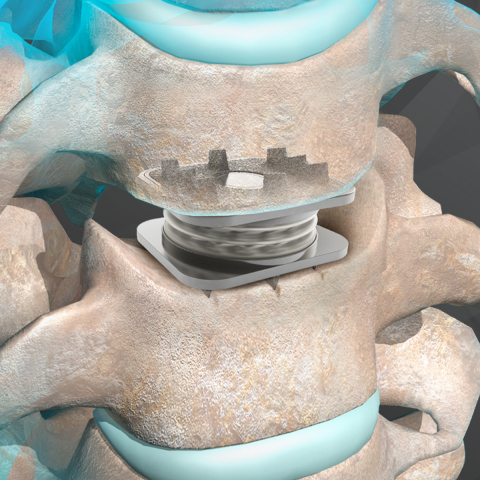Orthofix Announces Publication of Two-Year Data from the M6-C Artificial Cervical Disc Study
Orthofix Medical (NASDAQ:OFIX) published two-year data from its U.S. IDE study of the M6-C™ artificial cervical disc, demonstrating that the device is safe and effective for treating cervical disc degeneration. The study showed an overall success rate of 86.8% for M6-C patients compared to 79.3% for anterior cervical discectomy and fusion (ACDF) patients. At 24 months, M6-C patients reported significant reductions in pain and medication use, with a 91.2% improvement in neck pain. Orthofix aims to enhance patient outcomes with this innovative technology, emphasizing its commitment to quality-driven medical solutions.
- 86.8% success rate in M6-C disc patients compared to 79.3% in ACDF patients.
- 91.2% of M6-C patients reported improved neck pain.
- 92% satisfaction rate in M6-C patients with the surgery.
- Significantly lower opioid use in M6-C patients compared to ACDF, with 14% still on pain medication versus 38.2%.
- Reduced surgery time: 74.5 minutes for M6-C compared to 120.2 minutes for ACDF.
- Shorter hospital stay: 0.61 days for M6-C patients versus 1.10 days for ACDF patients.
- Only 1.9% of M6-C patients required subsequent surgery at the treated level.
- Slow adoption risk of the M6-C artificial cervical disc among spine surgeons.
- Potential for future studies to question the efficacy of the M6-C disc.
- Risk of competitors developing superior products impacting M6-C's market position.
- Insurance payers may decline reimbursement for M6-C procedures.
Insights
Analyzing...
Orthofix Medical Inc. (NASDAQ:OFIX), a global medical device company with a spine and extremities focus, today announced the publication of the full two-year data from its U.S. Investigational Device Exemption (IDE) study of the M6-C™ artificial cervical disc.

The Orthofix M6-C™ artificial cervical disc is a next-generation artificial disc developed to replace an intervertebral disc damaged by cervical disc degeneration. The M6-C disc is designed to restore motion to the spine and is an alternative to cervical fusion. (Photo: Business Wire)
Published in The Spine Journal, the study results show that treatment with the M6-C disc was safe, effective and noninferior to anterior cervical discectomy and fusion (ACDF) in treating patients with cervical disc degeneration. Designed to mimic a patient’s natural disc, the M6-C artificial cervical disc received U.S. Food and Drug Administration (FDA) approval in 2019.
“The full two-year data demonstrates that patients with degenerative cervical radiculopathy treated with the M6-C disc had significant improvements in neck and arm pain, function and quality of life scores,” said Dr. Frank Phillips, Professor of Orthopedic Surgery at Rush University Medical Center and a co-author of the journal article. “Additionally, these patients had a significant difference in the reduction of pain and opioid medications use when compared to ACDF patients. At 24 months, patients in the ACDF group who were still using pain medications had a seven times higher rate of opioid use than those in the M6-C disc group.”
“The publication of the two-year data is important as it provides surgeons around the world the opportunity to see the full results of the M6-C artificial cervical disc study to further understand the benefits of this unique next-generation technology,” said Orthofix President of Global Spine Kevin Kenny. “We are proud to be able to provide this life-changing technology to surgeons and their patients. The M6-C disc is representative of our commitment to deliver innovative, quality-driven solutions that can improve patients’ lives.”
The M6-C IDE study was a prospective, non-randomized, concurrently controlled clinical trial that evaluated the safety and effectiveness of the M6-C artificial cervical disc compared to ACDF for the treatment of single-level symptomatic cervical radiculopathy with or without cord compression.
Conducted at 23 sites in the U.S. with an average patient age of 44 years, the overall success rate for the protocol-specified primary endpoint for the M6-C disc patients was 86.8 percent at 24 months and 79.3 percent in the control group. This data statistically demonstrate that cervical disc replacement with the M6-C disc is not inferior to treatment with ACDF.
Secondary outcomes include:
- Patients who received the M6-C disc demonstrated statistically significant improvement in the Neck Disability Index as measured at week six and months three, six, 12 and 24.
- Overall, patients receiving the M6-C disc reported a 92-percent satisfaction rate with the surgery, and 93 percent said they would have the surgery again.
-
Prior to surgery, 80.6 percent of the M6-C disc patients and 85.7 percent of the ACDF patients were taking some type of pain medication for the treatment of their cervical spine condition. At 24 months, the rate of M6-C patients who were still taking some type of pain medication dropped to 14.0 percent compared to 38.2 percent of the ACDF patients.
- Of these, there was a seven times higher rate of opioid use with the ACDF patients than with patients who received the M6-C disc.
-
Meaningful clinical improvement in the following pain scores:
- 91.2 percent of patients who received the M6-C disc reported an improvement in neck pain compared to 77.9 percent in patients who underwent the ACDF procedure.
- 90.5 percent of the M6-C patients reported improvement in arm pain scores compared to 79.9 percent in ACDF patients.
- There was a statistically significant difference in the average mean surgery time – 74.5 minutes for patients receiving the M6-C disc versus 120.2 minutes for those patients having the ACDF procedure.
- In addition, there was a statistically significant difference in the mean length of hospital stay – 0.61 days for the M6-C patients versus 1.10 days for ACDF patients.
- There were no device migrations reported in the study.
- Subsequent surgery at the treated level was needed in 1.9 percent of the M6-C disc patients compared to 4.8 percent of the ACDF patients
- There were 3.8 percent serious adverse events related to the device or procedure in the M6-C disc group versus 6.1 percent in the ACDF group.
The M6-C disc received U.S. FDA approval in February 2019 based on the results of this study.
About the M6-C Artificial Cervical Disc
The M6-C artificial cervical disc is a next-generation intervertebral disc designed to restore physiologic motion to the spine for people needing artificial disc replacement as an alternative to cervical fusion. The device is comprised of ultra-high molecular weight polyethylene fiber wrapped in a specific pattern, with multiple redundant layers that create a fiber matrix (artificial annulus). The fiber is then wound around a polycarbonate urethane polymer core creating an artificial nucleus. Like a natural disc, this unique construct allows for shock absorption at the implanted level, as well as provides a controlled range of motion when the spine transitions in its combined complex movements. By allowing natural movement of the spine, the M6-C disc is designed to also potentially minimize the stress to discs above and below the treated level. To learn more visit M6disc.com.
About Orthofix
Orthofix Medical Inc. is a global medical device and biologics company with a spine and extremities focus. The Company’s mission is to deliver innovative, quality-driven solutions as we partner with health care professionals to improve patients’ lives. Headquartered in Lewisville, Texas, Orthofix’s spine and orthopedic extremities products are distributed in more than 70 countries via the Company's sales representatives and distributors. For more information, please visit www.Orthofix.com.
Forward-Looking Statements
This communication contains forward-looking statements within the meaning of Section 21E of the Securities Exchange Act of 1934, as amended, and Section 27A of the Securities Act of 1933, as amended, relating to our business and financial outlook, which are based on our current beliefs, assumptions, expectations, estimates, forecasts and projections. In some cases, you can identify forward-looking statements by terminology such as “may,” “will,” “should,” “expects,” “plans,” “anticipates,” “believes,” “estimates,” “projects,” “intends,” “predicts,” “potential,” or “continue” or other comparable terminology. These forward-looking statements are not guarantees of our future performance and involve risks, uncertainties, estimates and assumptions that are difficult to predict, including the risks described in Part II Item 1A under the heading Risk Factors of our Quarterly Report on Form 10-Q for the quarter ended September 30, 2020, and Part I, Item 1A under the heading Risk Factors in our Annual Report on Form 10-K for the year ended December 31, 2019 (the “2019 Form 10-K”). In addition to the risks described there, factors that could cause or contribute to such differences may include, but are not limited to: the risk that spine surgeons may be slow to adopt the M6-C artificial cervical disc; the risk that future patient studies or clinical experience and data may indicate that treatment with the M6-C artificial cervical disc does not improve patient outcomes as much as previously believed, or otherwise call into question the benefits of its use to patients, hospitals and surgeons; the risk that the product may not perform as intended and may therefore not achieve commercial success; the risk that competitors may develop superior products or may have a greater market position enabling more successful commercialization; the risk that insurance payers may decline to reimburse healthcare providers for the use of our products.
This list of risks, uncertainties and other factors is not complete. We discuss some of these matters more fully, as well as certain risk factors that could affect our business, financial condition, results of operations, and prospects, in reports we file from time-to-time with the Securities and Exchange Commission, which are available to read at www.sec.gov. Any or all forward-looking statements that we make may turn out to be wrong (due to inaccurate assumptions that we make or otherwise), and our actual outcomes and results may differ materially from those expressed in these forward-looking statements. You should not place undue reliance on any of these forward-looking statements. Further, any forward-looking statement speaks only as of the date hereof, unless it is specifically otherwise stated to be made as of a different date. We undertake no obligation to update, and expressly disclaim any duty to update, our forward-looking statements, whether as a result of circumstances or events that arise after the date hereof, new information, or otherwise.
View source version on businesswire.com: https://www.businesswire.com/news/home/20210128005275/en/







